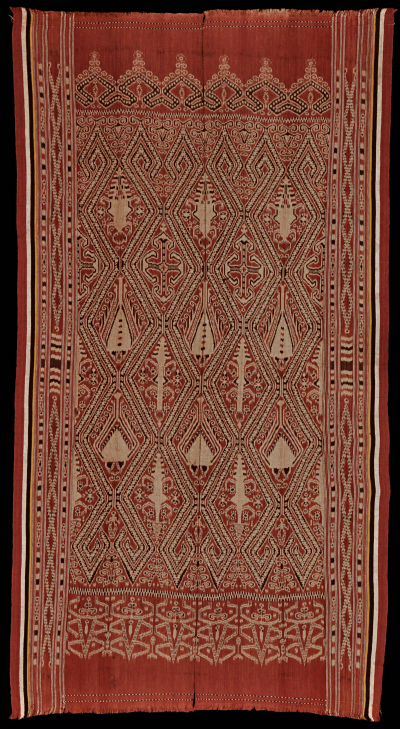| |
 
 | | | |
033 Borneo, Sarawak
Pua kumbu  
| | Locale: | Saribas, most likely. | | Period: | 1880 to early 20th c. | | Yarn: | Cotton, hand-spun, medium | | Technique: | Warp ikat | | Panels: | 2 | | Size: | 108 x 205 cm (3' 6" x 6' 8") LW: 1.90 | | Weight: | 760 g (26.8 oz), 343 g/m2 (1.12 oz/ft2) | | Design: | Serpents, nabau, enclosing zoomorphic figures which represent the nabau�s feed, the nature of which could not be identified. Feed may be illustrated according to the weaver's imagination, and a motif she comes up with is essentially her expression of the accepted canon of motifs that accompany, ngelagu, the main design or batang buah. Generally, these motifs represent corpses, human or animal. Human corpses can be depicted with head, with a diminutive head, or headless.�The motif in the top row is a variant of the Gerasi Demon motif, with three sets of limbs and a diminutive head. Gerasi is the perennial archenemy of Sengalang Burong, the Iban God of War. He was decapitated in the end, hence the diminutive heads. Borders in white, dark brown, brick red and faded yellow. | | Comment: | Pua kumbu with excellent weaving, panels well aligned. Only the yellow pin stripes were done in commercial thread, the rest is hand spun cotton. Even though there is some similarity to Ketungau cloths, several aspects firmly place this cloth in the Saribas. The main design, serpents and their feed, is a recurrent theme found throughout the Iban diaspora in Sarawak and amongst the Ibanic in Kalimantan but the top and bottom motifs are unmistakably Saribas, and the fine technique and sophisticated stylistics betray a quintessentially Saribas finesse. | | Background: | Chapters on Borneo and Sarawak. | | Exhibited: | Hong Kong University Museum and Art Gallery, 2017. | | Published: | Ikat Textiles of the Indonesian Archipelago, 2018.
| | Compare: | 032 | | Sources: | Similar to Khan Majlis, Indonesische Textilien, Wege zu Goettern und Ahnen, p.174/175, and fig. 679. Some parts similar to Katungau pua in Khan-Majlis, Textiles from Borneo (Amann Collection). Fig. 37. See also Gittinger, Splendid Symbols, Fig. 172. Squid-like motif representing headless man: Chaddon c.s. Iban or Sea Dayak Fabrics, Plate 1g. Scorpion, idem, Plate XVIIc. Overall pattern similar to Skran pua depicted in Heppell c.s., Iban Art, Fig. 48. All information except references to literature provided by Vernon Kedit. | | |

©Peter ten Hoopen, 2025
All rights reserved.
|
|


